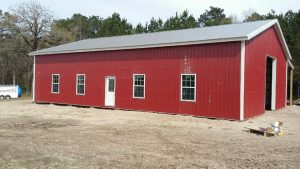CHALK, CHALK, CHALK
As kids, we grew up as the last house before the street surface changed from asphalt paving to dirt. Unlike today’s children, whose parents can buy “sidewalk chalk” in a myriad of colors, we improvised.
Whenever a new home was being drywalled near us, we would scrounge for scraps of sheetrock. As creative children of five and six years old, we’d use the edges of these pieces to outline chalk “roads” on the pavement.
Doing this manually was tedious as well as tough on our little backs, so we took things a step further. My red Radio Flyer® wagon was hitched to the back of my friend Danny’s older brother’s bike. Now the Radio Flyer® was designed for lots of things, however where we were going with this experiment, was probably none of those.
I’d lay down in the bed of the Radio Flyer® on my tummy, facing the rear. In each hand, a piece of sheetrock scrap. With the propulsion from the bike, we could produce (what to us anyhow) seemed like miles of chalk roads in no time at all.
Similar to the Ancient Roman adage, “It’s all fun and games until someone loses an eye”, is “It’s all fun and games until someone gets launched from the back of a Radio Flyer® wagon and fractures a clavicle”.
Thus was the end of our chalk roads.
Growing up in a family where my Dad and Uncles were framing contractors, we found out chalk had uses other than for making “roads”.
Developed in ancient Egypt (think pyramids) “chalk boxes” are used by carpenters to mark long, straight lines on relatively flat surfaces, much farther than is practical by hand or with a straight edge. A chalk box draws a straight line by the action of a taut cotton or similar string, which has been coated with colored chalk (most often blue or red, but other colors such as yellow, white and fluorescent orange are available).
The chalk box string is laid across the surface to be marked, then snapped sharply, causing the string to strike the surface leaving behind a straight chalk line where the surface has been struck.
We sadly now live in an overly litigious society, so the chalk box package reads like a television pharmaceutical commercial, “WARNING: TO AVOID RISK OF INJURY ALWAYS WEAR SAFETY GLASSES AND OTHER APPROPRIATE SAFETY ITEMS FOR PROTECTION. FAILURE TO DO SO CAN RESULT IN BODILY INJURY.” About the only thing more embarrassing than being launched from a Radio Flyer®, would be to incur a debilitating chalk box accident.
The really fine print adds, “CAUTION: RED, YELLOW, & FLUORESCENT CHALKS ARE PERMANENT COLORS. THERE IS NO KNOWN WAY TO REMOVE THEM.”
When it comes to the use of chalk near steel roofing and siding, the following warning should have been added:
NEVER SNAP CHALK LINES ON STEEL SHEETING.
 Even small moisture amounts will cause chalk dust lines (as well as any black or “lead” pencil marks) to permanently damage steel surfaces. These marks create an “electric cell”, which deteriorates the finish. This will cause chalk lines or pencil marks to be “seen” for the life of the building!
Even small moisture amounts will cause chalk dust lines (as well as any black or “lead” pencil marks) to permanently damage steel surfaces. These marks create an “electric cell”, which deteriorates the finish. This will cause chalk lines or pencil marks to be “seen” for the life of the building!
How do I know? The 100’ x 100’ warehouse for Hansen Buildings (built by someone else long ago) has beige steel siding with…you guessed it…horizontal somewhat faded (but still very obvious) red chalk lines on every






